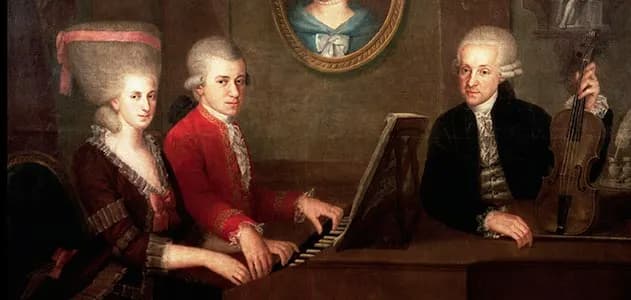When I read the announcement that Sylvia Milo’s solo play “The Other Mozart” would be presented in Little Rock at the CALS Ron Robinson Theater, I immediately wanted to see it. Especially since on that very day we were supposed to be in the capital of the State of Arkansas for our friend’s wedding.
If it were not for the informational help of the “all-knowing” Google, I would have thought that this performance would once again be about Wolfgang Amadeus Mozart‘s life and work, but only from some unusual side. However, this performance was dedicated to the composer’s older sister, Maria Anna Mozart. My relatives agreed to my proposal to spend Friday evening at the theater and bought tickets without hesitation.
In her article, “The Lost Genius of Mozart’s sister,” published in The Guardian on September 8, 2015, Sylvia Milo wrote that she had never heard Mozart had a sister. She found out about it when she saw a copy of a family portrait on the wall near the exit of the Mozarthaus in Vienna, depicting Leopold Mozart and his children, Maria Anna (Nannerl) and Wolfgang, sitting at the harpsichord. This painting intrigued Sylvia. Having decided to learn more about Nannerl’s fate, she carefully studied the history of the Mozart family, the time they lived, read their correspondences, etc. This is how the idea for the play “The Other Mozart” was born.

Mozart family portrait by Johann Nepomuk della Croce
I learned about Maria Anna Mozart at a children’s music school when the teacher told us that Wolfgang Amadeus Mozart and Felix Mendelssohn had talented sisters who were musicians. In addition, when I was older, I read the letters of the Mozart family that had come down to us. Nevertheless, I was interested in seeing the solo play of Sylvia Milo, which, by the time of the performance in Little Rock, had already been performed more than 300 times on stages in the USA, Canada, Europe, and Asia.
It must be said that Sylvia Milo did right, calling her work “The Other Mozart” and not “Mozart’s Sister” since several books with the same title had been published earlier: in 2005, the book by Alison Bauld; in 2006, the book by Nancy Moser; and in 2008, the book by Rita Charbonnier. In addition, in 2010, the film “Mozart’s Sister” directed by René Féret was released.
Maria Anna Mozart was born in Salzburg in 1751. She was four and a half years older than her younger brother Wolfgang. In the family, she was affectionately called Nannerl. She began learning the harpsichord at 7, and at 11, she was already performing complex sonatas and concertos. Leopold Mozart, the head of the family and a violin expert, took the children all over Europe from early childhood, demonstrating their outstanding musical abilities. During these travels, Wolfgang began composing. He wrote his First Symphony when he was only eight years old. Nannerl often helped her younger brother notate his music. However, very soon, instead of attending musical tours and concerts, Nannerl was forced to stay home and learn housekeeping to prepare for her future marriage. She grew up in the 18th century and had to obey the norms of her time and social customs.
After Leopold Mozart rejected Maria Anna’s suitor Franz Armand d’Ippold, a captain and private tutor, she married the magistrate Johann Baptist Reichsfreiherr von Berchtold zu Sonnenburg, who was 15 years older and a widower twice. Johann Baptist already had five children from his first two marriages, and Maria Anna bore him three more. Family concerns alienated her from Wolfgang, especially after his marriage to Constanze Weber. After her husband died in 1801, Maria Anna returned to Salzburg and continued to give piano lessons. At 74, she went blind, and four years later, she died in October 1829. Her grave is in St Peter’s Cemetery in Salzburg.
Sylvia Milo told the story of Nannerl’s life in 1 hour and 20 minutes—the length of the play. There was no one on stage except for the actress Daniela Galli, and the only attribute of the scenery was a giant 18th-century women’s dress (Magdalena Dabrowska, Costume Designer) which covered the stage.

Daniela Galli – The Other Mozart
As the plot develops, the dress symbolizes the limited world Maria Anna had to adapt to. In one of the final scenes, Galli squeezes herself into a metal corset (designed by Miodrag Guberinic), metaphorically conveying the idea of Nannerl’s enslavement within the generally accepted moral norms of the time.
Under the dim stage lighting (Joshua Rose, Lighting Designer), shimmering from silver to scarlet, the sounds of the harpsichord are heard. No score of Nannerl’s works has survived, so we cannot judge her talent as a composer. She stretches her arms forward and, closing her eyes, plays the keys of an imaginary instrument (Nathan Davis, Phyllis Chen, composers). When Nannerl talks about her brother, familiar fragments of Mozart’s sonatas, symphonies, and operas sound. Sometimes, Nannerl grimaces, reproducing Wolfgang’s loud laughter, and then the image of Amadeus, invented by Milos Forman, appears. And it is at this moment that one of Mozart’s saddest melodies sounds–Andante from Piano Concerto No. 23.
Wolfgang Amadeus Mozart: Piano Concerto No. 23 in A Major, K. 488 – II. Adagio (Lars Vogt, piano; Salzburg Mozarteum Orchestra; Ivor Bolton, cond.)

Daniela Galli – The Other Mozart
The performance ended and the audience gave a standing ovation to Daniela Galli, who, having transformed into an 18th-century girl, flawlessly played the role of Nannerl. As soon as we left the theater, we began discussing the play. We asked ourselves: “Perhaps the world has lost an outstanding musician?” It is no coincidence that in her narrative Nannerl often mentions her contemporary Marianne Martinez, a composer, harpsichordist and singer who, despite her fame, was unable to take a worthy position in society.
Was Maria Anna a better musician than Wolfgang Amadeus? Leopold Mozart wrote in one of his letters: “Nannerl no longer suffers from constant comparisons with her younger brother because she plays so beautifully that everyone admires her performance.” In the final scene, Nannerl laments that fate put her in second place from the very beginning. With a sad smile, she notes that even on her grave is written: Marianne Baroness von Berchtold zu Sonnenburg, sister of W. A. Mozart.
And how could it be otherwise? At all times, talent remained in the shadow of genius.
Mozart’s Sister Documentary Film Trailer
For more of the best in classical music, sign up for our E-Newsletter
Nadia Koval is a journalist and music critic. She was born in Kazakhstan. Prior to moving to Arkansas, United States, about 5 years ago, she lived in Argentina for 20 years, writing for publications such as QUID Magazine and Mozarteum Argentino. She is the author of a biography of Sergei Prokofiev (Spanish), as well as “Russian Musical Culture of the 20th Century” (Russian).





Brilliant article about the forgotten Mozart. Many Women Musicians / Composers of the 18th and 19th Century went into obscurity or were forced to become dutifull Wives and Mothers eg. Nannerl; Fanny Mendelssohn; Clara Schumann ; Louise Farrenc etc.